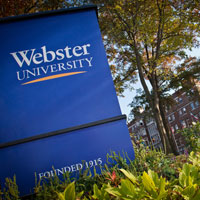Webster Earns Its Highest Ranking Ever on the U.S. News & World Report Best Colleges List
September 14, 2020

ST. LOUIS - Webster University earned its best ranking ever on the “2021 U.S. News & World Report Best Colleges” report, it was announced this morning. Webster rose to 15th place out of 157 Midwest regional universities. Since 2009, Webster has risen 18 places on the list.
Webster also earned its highest peer assessment score and was recognized for excellence in several subcategories.
“We welcome this external validation of the quality with which Webster's dedicated faculty and staff provide a superior education for our globally diverse students,” said Webster University Chancellor Elizabeth (Beth) J. Stroble. “This community's innovation, resilience, and commitment to meeting students' needs built a strong reputation for the University, which is reflected in our second-straight record-breaking ranking and a strong recognition from our peers.”
The 15th place ranking in the Regional Universities – Midwest ranking is the highest Webster has earned since the U.S. News & World Report list was first published in 1983. Last year, Webster was ranked 17th, which also was a record at the time. The Midwest Regional University category includes all universities in Missouri, Michigan, Illinois, Wisconsin, Indiana, Ohio, Iowa, Kansas, Nebraska, Minnesota, North Dakota and South Dakota that offer undergraduate and graduate degrees, but few or no doctoral programs.
In the State of Missouri, Webster earned the third-best ranking among all institutions in the Midwest category. Webster was ranked as the best Midwest Regional University in the St. Louis region.
Webster’s peer assessment score rose to 3.0 this year, a new best for the institution. That score is based on a survey of presidents, provosts and deans of admissions at institutions in the Midwest category, who are asked by U.S. News & World Report to rate the academic quality of peer institutions with which they are familiar on a scale of 1 to 5.
The peer assessment score contributed to 20 percent of Webster’s overall score. Other factors that contributed to Webster’s record ranking include:
- An increase in Webster University’s one-year retention rate. Webster freshman to sophomore retention rate has risen to 78%.
- An increase in the amount of financial aid offered to students. The average amount of financial aid awarded to undergraduate students during a two-year period increased from $23,880 to $24,921.
- An increase in the percentage of faculty with higher degrees. More than 86% of Webster’s full-time faculty have the highest degree offered in their field.
- An increase in the percentage of overall faculty who are full-time. Nearly two-thirds of Webster’s faculty on the Webster Groves campus are full-time.
“Even while faced with extraordinary challenges, Webster University continues to invest in the success of our students and to empower them to build a brighter and better future,” said Webster University President Julian Z. Schuster. “These record rankings are telling validations of our unwavering dedication to advancing our mission and better serving students and communities here in St. Louis and around the world.”
In the subcategories, Webster University was recognized for:
- “Best Colleges for Veterans.” This is the ninth consecutive year Webster was named as an institution that helps veterans and active duty service members pursue, pay for, and complete their degrees. Nearly one-fifth of all of Webster’s students are current services members, military veterans or former service members.
- “Top Performers in Social Mobility.” U.S. News & World Report reviewed the graduation rates of Pell Grant recipients to non-Pell Grant recipients to determine which institutions to include in this category. Pell Grants are federal grants awarded to students from households that earn less than the national average income. This allows the ranking service to measure how students from less affluent households perform when compared to those from wealthier homes. Traditionally, lower-income students have significantly higher drop-out rates due to the financial challenges they face.
- “Economic Diversity Among Top 25” – This is based on the percentage of incoming students who receive Pell Grants, a federal financial aid package for students who come from homes that make less than the average income in the United States. Webster University was ranked third on this list for the top 25 schools in the Midwest University category.
- “Best Value School” among Midwest Institutions. Webster is recognized in this category for balancing the net cost of attendance, need-based financial aid, and above-average academics.
The complete U.S. News & World Report rankings can be found online at www.usnews.com/best-colleges.
